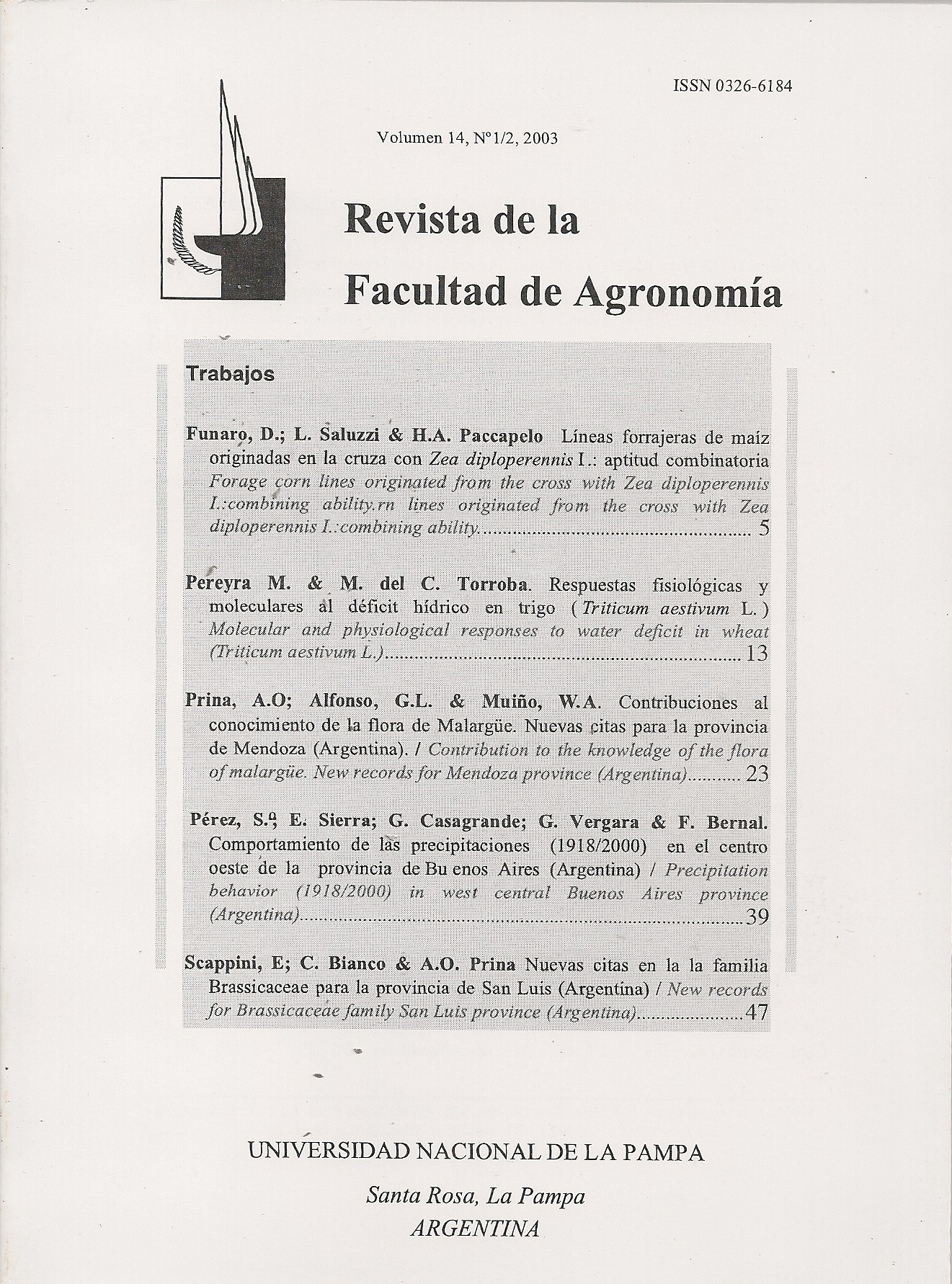Precipitation behavior (1918/2000) in west central Buenos Aires province (Argentina)
Keywords:
Cycle, precipitation, Western Center of Buenos Aires,Abstract
During the last decades, the western center of the province of Buenos Aires registered a significant increase of the grain cultivation area due to the increase of the demand of cereals and oil crops and to the technological innovations. There are indications which show that that process was favored by the increase in the precipitations which started in the beginings of the 60. From this, a study of the changes of the precipitations in the area was carried out, with the purpose to evaluate its influence in the process. In the evaluated period (1918/2000), it could be verified that, according to the indicated works oi investigation made previously, the region presented a cycle of long duration with damp and dry phases, separated by phases of transition, that extended approximately during the following periods: 1} End of a phase of transition wet/dry between the beginning of the period evaluated and the mid 20s; 2) Dry phase between the mid 20s and the late 40s; 3) Phase of transition dry/wet between the early 50s and the 70s; 4) wet phase between the mid 70s and the late 90s. To be a strip of transition between the damp climate of the Eastern region and the semi-arid climate that extends towards the west of Argentina, the area presents a high vulnerability to the fluctuations of the rain regime, therefore it is necessary to anticipate the consequences that would bring entailed the return to periods of low precipitations. It must be considered the importance of developing technological resources that allow to surpass a possible diminution of rains during the next decades.
Downloads
References
Castaneda ME. & V. Barros. 1994. Las tendencias de la precipitación en el Cono Sur de America al este de los Andes. Meteorológica, 19(1y2):23-32.
Downing TE. 1996. Ciimate change and world food security. NATO ASI Series I: Global Environmental Change 37, Springer, Berlin, 662 pp.
Parry, M.I.I 990. Climate Change and world agriculture. Earthscan. Lxindon. 157 pp.
Pizarro, J.B. & A.R. Cascardo. 1991. El desarrollo agropecuaria pampeano. 799 Pag. Cap IV La evolución de la agricultura pampeana. Grupo editor latinoamericano. Osvaldo Barsky editor.
Perez, S,, E.M. Sierra, G. Casagrande & G. Vergara. 1999. Cambios en el régimen de precipitaciones del oeste de la Region Pampeana Argentina 1921-98, XI Congreso Brasilero de Agrometeorología y II Encuentro Latinoamericano de Agrometeorologia. Floriandpolis. Brasil. Anales 499.
Roberto, Z.E., G, Casagrande & E.R Viglizzo. 1994. Lluvias en la Pampa Central: tendencia y variaciones del siglo. Cambio Climático y Agricultura Sustentable en ia Región Pampeana. Bol. INTA Centro Regional La Pampa-San Luis, N° 2, 25pp.
Sierra, E.M., R.H. Hurtado& L, Spascha. 1994. Corrimiento de las isoyetas anuales medias decenales en la Región Pampeana 1941-1990. Rev. Fac. Agr, 14(2):139-144,
Sierra, E.M, M, Conde Prat & S, Pérez. 1995. La migración de cultivos de granos como indicador del cambio climático 1941-93 en la Región Pampeana Argentina. Rev. Fac. Agr. 15(2-3):171-176.
Snedecor, G.W. S. W.G. Cochran, 1980. Statistical methods. The Iowa State University Press, 507 pp.
Trewartha G.T 1968, An introduction to weather and climate. New York, Mc.Graw-Hilt.
Watson R,, M, Zinyowera & R. Moss. 1996. Climate Change 1995- Impacts, Adaptation and Mitigation of Climate Change. Contribution of WG II to the Second Assessment Report of the IPCC, Cambridge University Press, Cambridge.
Downloads
Published
Issue
Section
License
La Editorial de la Universidad Nacional de La Pampa (EdUNLPam) exigirá a los/as autores/as la firma del siguiente documento:
La EdUNLPam lleva a cabo la publicación del artículo: (Título del Artículo) en SEMIÁRIDA Rev.Fac.Agron UNLPam ISSN 2362-4337 (impresa) ISSN 2408-4077 (en línea), del cual el/los abajo firmantes son autores de una o más partes. En el mismo acto, el/los autores entregan exclusivamente a la EdUNLPam todos sus derechos protegidos por las leyes de propiedad intelectual que rigen en la Argentina para reproducir, publicar, editar, fijar, comunicar y transmitir públicamente en cualquier formato o medio impreso o electrónico, inclusive internet, el artículo enviado a publicación e incluirlo en índices o bases de datos nacionales e internacionales. A cambio, la EdUNLPam entrega a los autores la autorización para la publicación o reimpresión con ines académicos y educativos en cualquier libro o medio de divulgación, con la sola obligación de citar el artículo original publicado en la EdUNLPam. Cada autor acuerda en que el material provisto a la EdUNLPam es un trabajo original, que no ha sido impreso o publicado en cualquier otro medio con anterioridad y que no vulnera derechos de terceros. El Primer autor tendrá la posibilidad de leer y corregir el artículo ya editado como “prueba de galera”, pero si el autor no devolviera esas correcciones de la prueba de galera dentro del tiempo especificado, el proceso de producción y publicación podrá proseguir sin la aprobación del autor. El/los autor/es no recibirán compensación monetaria de la EdUNLPam por el uso del material contenido en este artículo y asumen la responsabilidad de las opiniones vertidas en él.






.png)



22.png)



.jpg)




.jpg)
